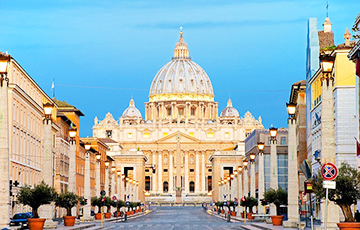Vatican Conclave Begins Today: Who The Favorites Are
3- 7.05.2025, 7:53
- 7,538

The pope will be chosen by 133 cardinals.
On Wednesday, May 7, the conclave, a special gathering of Roman Catholic cardinals to elect a new pope, will begin at the Vatican. He will be the 267th pontiff to succeed the deceased Pope Francis, reports New Voice.
The pope will be chosen by 133 cardinals who have traveled to the Vatican from around the world. There are more than 250 Roman Catholic cardinals in total, but only those under the age of 80 are eligible to vote in the conclave.
How does the conclave take place?
To be elected, the new pontiff must receive at least 2/3 of the conclave's votes in a secret ballot. There is no age limit for the pope and any male Catholic can become pope, but most often the head of the Holy See is chosen from among the cardinals.
On May 7, all cardinal-electors will gather and be locked in the Sistine Chapel, the most famous papal chapel in the Vatican's Apostolic Palace, where the conclave is held. All of them must have taken an oath on the Gospel to observe the sacrament of ceremony.
Cardinals must enter the Sistine Chapel to the Christian hymn Veni Creator Spiritus. Next, the chapel doors are closed from the inside. This "isolation" of the cardinals continues until they elect a new pope, even if it lasts for several days. This procedure is designed to eliminate outside influence or pressure on the electors.
A secret ballot must be held in the Sistine Chapel. Cardinals inscribe the name of the chosen candidate, distorting the handwriting for anonymity. Voting continues until one of the candidates receives two-thirds of the votes.
On the first day of the conclave there is only one vote, then four per day. Black smoke from the burned ballots over the Sistine Chapel means that the pontiff has not yet been elected.
If, however, after the next counting of votes, one of the candidates gets the required number and agrees to become pope, the ballots are burned one last time, and white smoke rises over the Sistine Chapel, announcing the successful election. To keep this tradition alive, a special chimney, which is used during the conclave, was installed on the roof of the chapel on May 2, with two cast-iron stoves 30 meters below it. To ensure the signal from the chimney is a clear color, Vatican experts use separate combinations of chemical compounds for black and white smoke, the BBC explains.
The new pontiff must choose a name for his pontificate and assume the office of pope. He goes to the Room of Tears, where he changes his clothes from the red "cardinal's" vestments to the white robes of the pope.
The oldest cardinal deacon announces the result of the conclave from the balcony of St. Peter's Basilica, and the newly elected pope makes his first speech from there.
The conclave on May 7, 2025, is the 26th conclave to be held in the Sistine Chapel, the Vatican press office recalls. It will also be the 76th such event in the established format, which in its main principles was founded by Pope Gregory X in 1274. His own "election" stretched over a record two years and two months, so it was Gregory X who later established the requirement to isolate cardinals during voting and limit outside influence on them. The fastest conclave took place in 1503, when Pope Julius II was elected in just a few hours.
Conclaves usually last several days. Pope Francis was elected relatively quickly: he was elected on March 13, 2013, after five rounds of voting in less than two days.
Who could be elected the new pope: the main contenders.
Experts say there is not yet one clear favorite to succeed Francis, but the New York Times has previously mentioned several names of the most likely candidates.
Anders Arborelius, Archbishop of Stockholm.
The first Catholic cardinal hails from Sweden.
Saw the church's main challenge as building bridges in a polarized world. Advocate for greater influence of women in Catholicism.
Peter Erde, Archbishop of Esztergom-Budapest (Hungary).
Expert on canon law. Considered a conservative, a supporter of the policies of John Paul II and Benedict XVI. A diplomat known for his ability to forge ties between Catholics on different continents and between different religious movements. Repeatedly visited memorials to Holocaust victims.
Matteo Zuppi, Archbishop of Bologna (Italy).
Has been close to the previous pope's beliefs that the church's primary mission is to help the poor.
Has publicly expressed support for the Catholic LGBT community. He is rumored to be the one Francis saw as his successor, but there is no confirmation of this.
Luis Antonio Tagle, a curial cardinal from the Philippines.
Prelate of liberal views, known as the "Asian Francis" or Chito. Could become the first pope from northeast Asia.
Has a smiling personality. Places great emphasis on the role of the church in the Third World. He has been involved in some of the most heated intra-church discussions, among them the admission to communion of divorced Catholics and those who have remarried.
Fridolin Ambongo, Archbishop of Kinshasa (DR Congo).
Very close to Francis, one of nine members of the Council of Cardinals. However, he opposed the previous pope's agreement to bless homosexual couples.
He has a chance to become the first black pontiff.
Pietro Parolin, Vatican Secretary of State.
He has determined the Holy See's foreign policy throughout Francis' pontificate.
He is considered a centrist. Experts say no one knows the mood of the curia better than him.
Pierbattista Pizzaballa, Latin Patriarch of Jerusalem.
Favorite of the conclave, along with Parolin. His experience in the hot spot, the Middle East, may come in handy for him. At the same time, he has been away from the Vatican for quite some time.
At 60, he is the youngest contender for bishop of Rome.











